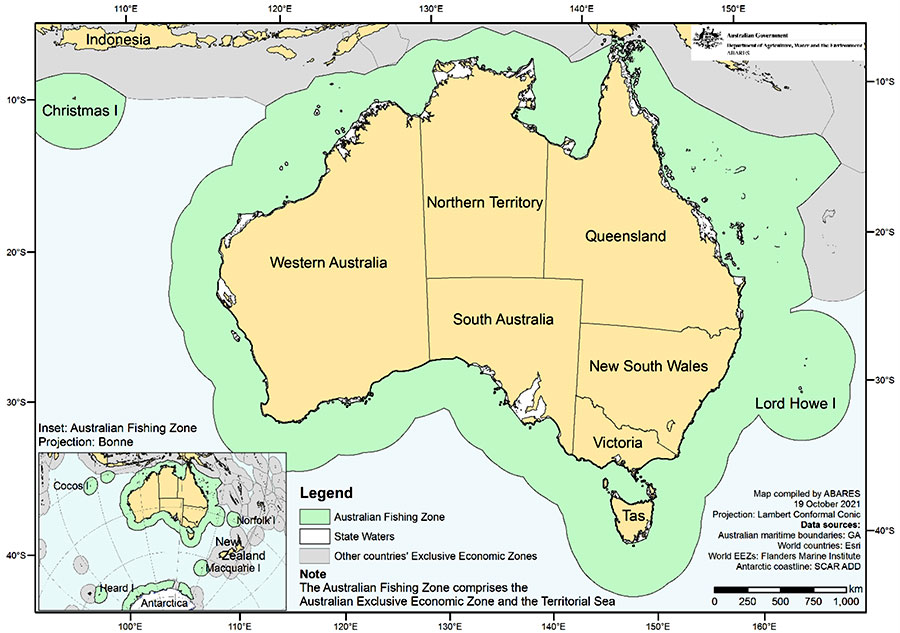Authors: Daniel Wright, Kurt Davis, Stephanie Blake, Tim Emery, Ian Butler, Brooke D’Alberto and James Woodhams
Overview
This report provides a synthesis of management arrangements, catch and sustainability of sharks across Australia. This report is a commitment under the United Nations Food and Agriculture Organisation's International Plan of Action for the Conservation and Management of Sharks and Australia's National Plan of Action for the Conservation and Management of Sharks.
A resolution on the status of international trade in sharks was adopted at the ninth conference of parties to the Convention on International Trade in Endangered Species of Wild Fauna and Flora (CITES) in 1994. The resolution called for a review of information on the global status of shark stocks and the impact of trade on those stocks. Subsequently, the Food and Agriculture Organization (FAO) of the United Nations released the International Plan of Action for Conservation and Management of Sharks (IPOA‒Sharks) in 1999.
The IPOA‒Sharks is a voluntary instrument directing FAO member nations to ‘adopt a national plan of action for the conservation and management of shark stocks (NPOA‒Sharks) if their vessels conduct directed fisheries for sharks or if their vessels regularly catch sharks in non-directed fisheries’. The IPOA‒Sharks also directs nations implementing an NPOA‒Sharks to frequently reassess their plans, preferably every four years, to continually identify cost-effective strategies for increasing effectiveness.
Australia’s first NPOA‒Sharks was developed in 2004 (DAFF 2004), informed by the nation’s first shark assessment report (SAR) in 2001 (DAFF 2001). A second NPOA‒Sharks was developed in 2012 (NPOA‒Sharks II: DAFF 2012), supported by a second SAR prepared in 2010 (Bensley et al. 2010). A third SAR was developed in 2018 (Woodhams & Harte 2018), which informed a review of the NPOA‒Sharks II.
This fourth edition of Australia’s SAR has been developed with the assistance of the Shark-Plan Representative Group (SRG) and will inform a review of Australia’s NPOA‒Sharks II in 2022. This SAR provides updated information on:
- shark catch, trade and stock status
- anthropogenic and environmental impacts
- fisheries management and regulatory frameworks
- conservation and management arrangements.
This SAR was developed using publicly available information and data sourced from each jurisdiction. In addition, catch and trade data compiled by the FAO and the Australian Bureau of Statistics (ABS) are used.
The 2022 SAR provides a consolidation of jurisdictional catch data between 2015–16 and 2019–20 and every attempt has been made to ensure accuracy at the time of publication. Standard Australian fish names have been used where possible. When used, the term ‘sharks’ refers collectively to species or species groups of sharks, rays and chimaeras.
State and territory fisheries agencies generally manage fisheries out to 3 nautical miles, while the Australian Government generally manages fisheries in waters from 3 nautical miles out to 200 nautical miles. There are several exceptions to these general rules, with a number of Offshore Constitutional Settlement (OCS) arrangements established to manage fish stocks that occur in more than one marine jurisdiction. Under these OCS arrangements, fishing for a particular fish stock may be managed either through joint authority arrangements made between two or more jurisdictions or by transferring management of a straddling stock to a single jurisdiction. For example, under OCS arrangements, the Commonwealth manages commercial fishing for gummy shark (Mustelus antarcticus) in coastal waters off south‐eastern Australia on behalf of Victoria, South Australia and Tasmania (Commonwealth Gazette 2000a, b, 2001).
This report principally considers data and information for fisheries operating within the Australian Fishing Zone and State Waters (Map 1). Some information is also presented for straddling and/or high seas stocks.
Map 1 Australian Fishing Zone
Shark Assessment Report 2022 (PDF 2.39 MB)
Shark Assessment Report 2022 (DOCX 3.57 MB)
If you have difficulty accessing these files, visit web accessibility for assistance.

